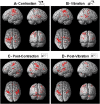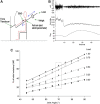Experimental investigations of control principles of involuntary movement: a comprehensive review of the Kohnstamm phenomenon
- PMID: 28374088
- PMCID: PMC5486926
- DOI: 10.1007/s00221-017-4950-3
Experimental investigations of control principles of involuntary movement: a comprehensive review of the Kohnstamm phenomenon
Abstract
The Kohnstamm phenomenon refers to the observation that if one pushes the arm hard outwards against a fixed surface for about 30 s, and then moves away from the surface and relaxes, an involuntary movement of the arm occurs, accompanied by a feeling of lightness. Central, peripheral and hybrid theories of the Kohnstamm phenomenon have been advanced. Afferent signals may be irrelevant if purely central theories hold. Alternatively, according to peripheral accounts, altered afferent signalling actually drives the involuntary movement. Hybrid theories suggest afferent signals control a centrally-programmed aftercontraction via negative position feedback control or positive force feedback control. The Kohnstamm phenomenon has provided an important scientific method for comparing voluntary with involuntary movement, both with respect to subjective experience, and for investigating whether involuntary movements can be brought under voluntary control. A full review of the literature reveals that a hybrid model best explains the Kohnstamm phenomenon. On this model, a central adaptation interacts with afferent signals at multiple levels of the motor hierarchy. The model assumes that a Kohnstamm generator sends output via the same pathways as voluntary movement, yet the resulting movement feels involuntary due to a lack of an efference copy to cancel against sensory inflow. This organisation suggests the Kohnstamm phenomenon could represent an amplification of neuromotor processes normally involved in automatic postural maintenance. Future work should determine which afferent signals contribute to the Kohnstamm phenomenon, the location of the Kohnstamm generator, and the principle of feedback control operating during the aftercontraction.
Keywords: Action awareness; Action inhibition; Aftercontraction; Involuntary movement; Muscle afferents; Posture.
Conflict of interest statement
The authors declare no competing financial interests.
Figures










Similar articles
-
Low Gain Servo Control During the Kohnstamm Phenomenon Reveals Dissociation Between Low-Level Control Mechanisms for Involuntary vs. Voluntary Arm Movements.Front Behav Neurosci. 2018 May 30;12:113. doi: 10.3389/fnbeh.2018.00113. eCollection 2018. Front Behav Neurosci. 2018. PMID: 29899692 Free PMC article.
-
Sensorimotor organization of a sustained involuntary movement.Front Behav Neurosci. 2015 Jul 28;9:185. doi: 10.3389/fnbeh.2015.00185. eCollection 2015. Front Behav Neurosci. 2015. PMID: 26283934 Free PMC article.
-
Voluntary motor commands reveal awareness and control of involuntary movement.Cognition. 2016 Oct;155:155-167. doi: 10.1016/j.cognition.2016.06.012. Epub 2016 Jul 8. Cognition. 2016. PMID: 27399155
-
Voluntary inhibitory motor control over involuntary tic movements.Mov Disord. 2018 Jul;33(6):937-946. doi: 10.1002/mds.27346. Epub 2018 Mar 6. Mov Disord. 2018. PMID: 29508917 Review.
-
Aspects of body self-calibration.Trends Cogn Sci. 2000 Jul;4(7):279-88. doi: 10.1016/s1364-6613(00)01493-5. Trends Cogn Sci. 2000. PMID: 10859572 Review.
Cited by
-
Muscle spindle thixotropy affects force perception through afferent-induced facilitation of the motor pathways as revealed by the Kohnstamm effect.Exp Brain Res. 2018 Apr;236(4):1193-1204. doi: 10.1007/s00221-018-5207-5. Epub 2018 Feb 21. Exp Brain Res. 2018. PMID: 29468386
-
Towards real-world generalizability of a circuit for action-stopping.Nat Rev Neurosci. 2021 Sep;22(9):538-552. doi: 10.1038/s41583-021-00485-1. Epub 2021 Jul 29. Nat Rev Neurosci. 2021. PMID: 34326532 Free PMC article. Review.
-
Neural dynamics of illusory tactile pulling sensations.iScience. 2022 Aug 26;25(9):105018. doi: 10.1016/j.isci.2022.105018. eCollection 2022 Sep 16. iScience. 2022. PMID: 36105590 Free PMC article.
-
Human Postural Control.Front Neurosci. 2018 Mar 20;12:171. doi: 10.3389/fnins.2018.00171. eCollection 2018. Front Neurosci. 2018. PMID: 29615859 Free PMC article. Review.
-
Efference copy in kinesthetic perception: a copy of what is it?J Neurophysiol. 2021 Apr 1;125(4):1079-1094. doi: 10.1152/jn.00545.2020. Epub 2021 Feb 10. J Neurophysiol. 2021. PMID: 33566734 Free PMC article. Review.
References
-
- Allen F. The post-contraction of the muscles of the arm. Q J Exp Physiol. 1937;26(4):305–317.
-
- Allen F, O’Donoghue C. The post-contraction proprioceptive reflex, its augmentation and inhibition. Q J Exp Physiol. 1927;18(3):199–242.
Publication types
MeSH terms
LinkOut - more resources
Full Text Sources
Other Literature Sources
Medical

